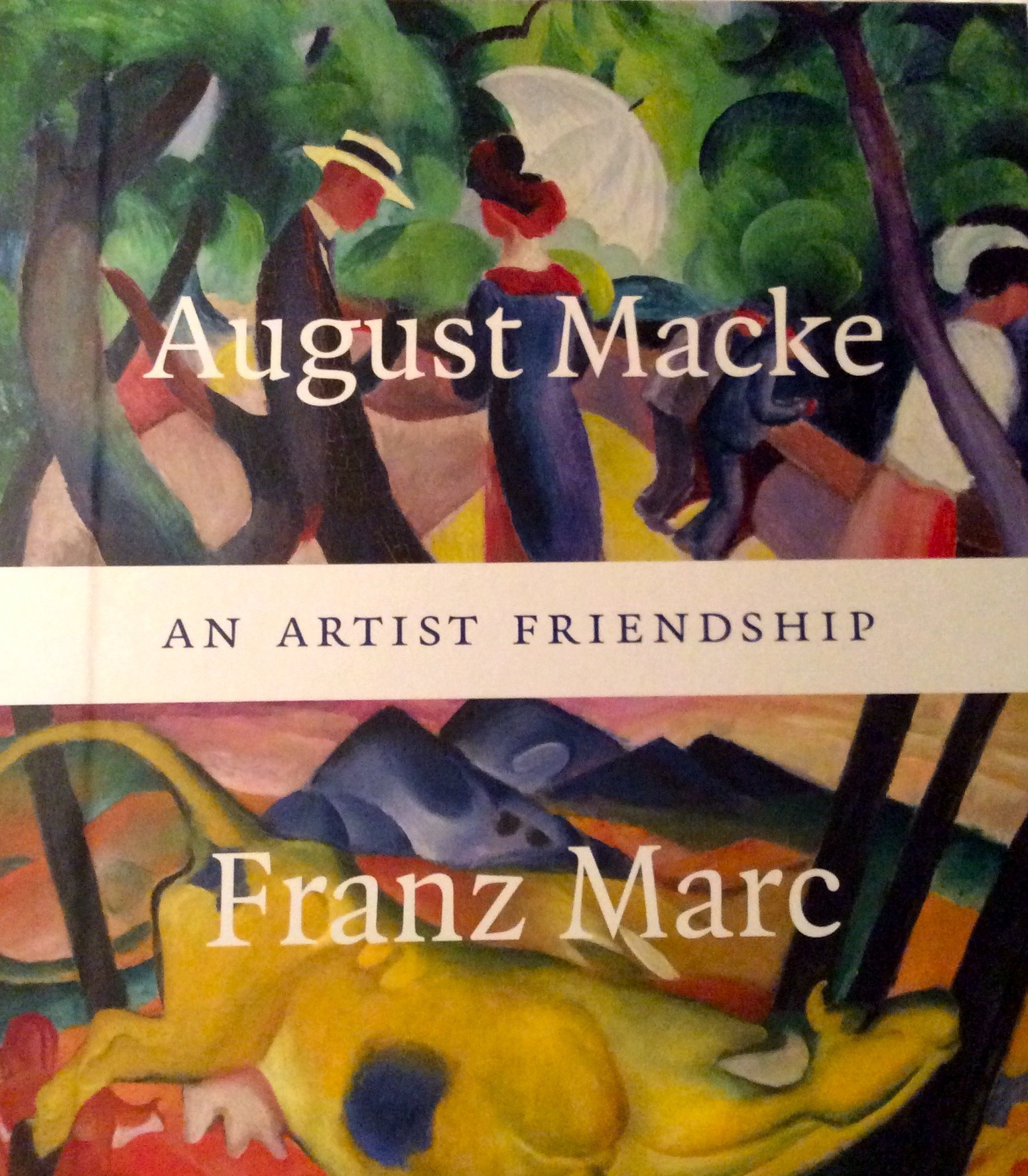Book Review: August Macke and Franz Marc: An Artist Friendship
Catalog of an exhibition held at the Kunstmuseum Bonn, 25 September 2014 – 4 January 2015; and at the Städtische Galerie im Lenbachhaus und Kunstbau, Munich, 28 January – 3 May 2015; 359 pages with many color illustrations and black and white archival photographs.
I recently began doing some book reviews for Museum Bookstore, an online repository of catalogues and other printed material generated on behalf of museum and gallery exhibitions. My first review is of my favorite book of 2014-2015, the outstanding catalogue presented by the Lenbachhaus and Kunstmuseum Bonn in support of August Macke und Franz Marc: eine Künstlerfreundschaft. Please support this very worthy independent bookstore effort by checking out the companion text on the site.
§ § §
Published on 26 September 1914 to coincide with the 100th anniversary of the death of August Macke as well as the launch of the ambitious cooperative retrospective of Macke’s and Franz Marc’s overlapping oeuvres, the exhibition catalogue August Macke and Franz Marc: An Artist Friendship (August Macke und Franz Marc: eine Künstlerfreundschaft is its twin in the original German from which the English version has been translated) is, perhaps not surprisingly, a tour-de-force of editing and research. What is unexpected is that the editors, longtime Lenbachhaus Blaue Reiter curator Annegret Hoberg and Volker Adolphs of Kunstmuseum Bonn, along with a smartly-assembled team of university- and museum-based German art historians, bring to bear not just a wealth of knowledge but so much compassion to these essays, confronting directly the loss and sadness we naturally feel over the too-short lives of Marc and Macke. Macke, the extroverted Rhinelander, was killed in Champagne, France, at 27, while Marc, the contemplative Bavarian, died aged 36 at Verdun in the spring of 1916.
 Despite their frank sentimentality, the catalogue’s chapters and essays are impeccably scholarly. Hoberg’s “August Macke and Franz Marc / Ideas for a Renewal of Painting” and Adolphs’ “Seeing the World and Seeing Through the World / Nature in the Work of August Macke and Franz Marc” are classic art historiography based in peerless analysis. Hoberg focuses on the milieu of the international avant-garde that encouraged Marc and Macke to not only follow the careers of but become personally acquainted with the Parisian Orphist Robert Delaunay and the Italian Futurist Umberto Boccioni. While Marc’s primary subjects directly encompass animals and the pastoral, albeit reframed through a unique pantheistic realism, Macke, who often painted urban scenes, has a less direct relationship to “nature,” which Adolphs teases out, particularly in comparison to Marc.
Despite their frank sentimentality, the catalogue’s chapters and essays are impeccably scholarly. Hoberg’s “August Macke and Franz Marc / Ideas for a Renewal of Painting” and Adolphs’ “Seeing the World and Seeing Through the World / Nature in the Work of August Macke and Franz Marc” are classic art historiography based in peerless analysis. Hoberg focuses on the milieu of the international avant-garde that encouraged Marc and Macke to not only follow the careers of but become personally acquainted with the Parisian Orphist Robert Delaunay and the Italian Futurist Umberto Boccioni. While Marc’s primary subjects directly encompass animals and the pastoral, albeit reframed through a unique pantheistic realism, Macke, who often painted urban scenes, has a less direct relationship to “nature,” which Adolphs teases out, particularly in comparison to Marc.
Gregor Wedekind’s “The Masks of the Savages / Primitivism and Cultural Critique in the Work of August Macke and Franz Marc” is of great contemporary interest as it underscores how the work of the Blaue Reiter was received in its time as a shocking departure from what the German art world then considered “civilized” artistic expression. There are a few small errors of biography marring Klara Drenker-Nagels’ otherwise illuminating discussion of the relationship between the artists’ wives, Maria Marc and Elisabeth Erdmann-Macke, perhaps generated by translation issues.
During their four-year relationship, the Marcs and Mackes often traveled together and visited each other’s home. While they were apart, they exchanged scores of letters and postcards. Many of these exchanges concerned painterly matters of colour theory and art history. Others, however, are ribald and often hilarious accounts of encounters with other artists and art dealers in their circle, including Wassily Kandinsky, Gabriele Münter, Max Beckmann, and Herwarth Walden, gallerist to the Blaue Reiter and impresario of Der Sturm. Excerpts from some of those letters, along with a contextualization of commentary and attendant artworks, are also reproduced in the catalogue.
Of special delight in terms of the arrangement and presentation of the catalogue are some shorter, data-packed single-pages interspersed throughout, such as on the Paradies (1912) mural Marc and Macke created together in Macke’s Bonn atelier, and other anecdotes about the pair’s overlapping, but ultimately very different lives.
Of course the catalogue is rich with the highly-coloured reproductions of the paintings, weavings, sketches, and photos that graced the exhibition itself. As a discrete publication, this is one that may truly be enjoyed as a book – I received it on a Friday afternoon and spent the entire weekend poring over every image, footnote, and phrase, alternately smiling and wiping away tears. Turning the last page, I was filled with admiration for this Lenbachhaus-Kunstmuseum Bonn collaboration, every word written with love – a very welcome departure from the arid tone of so much of the prose that has been devoted to events that took place only a short century ago.
Edited by Volker Adolphs of the Städtisches Kunstmuseum Bonn and Annegret Hoberg of the Städtisches Galerie im Lenbachhaus, Munich.
Ostfildern: Hatje Cantz, 2014.
ISBN: 97837775738835
 RSS - Posts
RSS - Posts